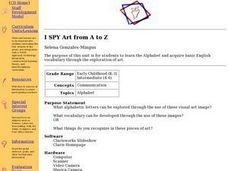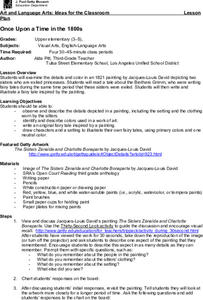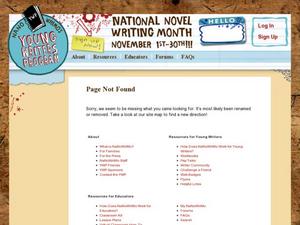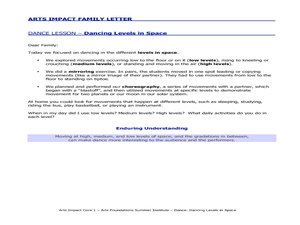Curated OER
Language Review #7
In this language review #7 worksheet, students edit and punctuate 3 sentences, write fact or opinion for 2 sentences, select words that are spelled correctly and write synonyms for 2 words.
Curated OER
Language Practice
In this language worksheet, students answer questions about real or make believe, spelling, editing, and choosing the correct word. Students complete 4 problems.
Curated OER
I SPY Art from A to Z
Students explore the Alphabet and acquire basic English vocabulary through the exploration of art. They find the alphabet in a variety of visual art images the teacher provides for them. Students count, sort and categorize Alphabet...
Curated OER
Say "Thank You" in 100 Languages!
Learners put the "Thanks" back in Thanksgiving with this geography and language activity that teaches students to say "thank you" in many languages.
Curated OER
Three-Way Match: Famous Black Americans
Pupils research famous African-Americans using an online resource. They complete a three-way matching activity.
Curated OER
Art Criticism for Elementary
Students view various pieces of art and identify their basic elements. Using the art, they present the elements to the class in a presentation. They answer questions and organize them into written form. They also write and reflect on...
Curated OER
The Great Art of Henri Matisse
Learners discover the artistic works of Henri Matisse, and examine what his work means. In this art lesson plan, students observe the different paintings/collages of Henri Matisse, eventually creating works of their own based on his style.
Curated OER
Daily Oral Language Activities: Idioms
Third graders examine the use of idioms. In this vocabulary and reading lesson, 3rd graders explore what idioms are and make their own idiom cards to help them understand the use idioms in language.
Curated OER
Moby Dick Puppetry
Such an ambitious lesson! Third graders with special needs listen to an audio recording of the novel, Moby Dick. They stop often to discuss each of the main characters and analyze their actions in the story. They then make puppets of one...
Curated OER
Once upon a Time in the 1800's
Young readers examine the details in an 1821 painting by Jacques-Louis David depicting two sisters who are exiled princesses. They read a tale about the Brothers Grimm, who were writing fairy tales during the same time period that these...
Curated OER
Lesson Plan 4: Creating Main Characters
Creating a good main character is a must when writing a creative narrative or novel. Elementary aged writers create main characters for the novel they are writing. They first use themselves as a models, then create a character as a...
Curated OER
Lesson Plan 5: Creating a Supporting Character
As a class, young writers learn how to develop a strong supporting character. They think and discuss a good friend they know, they use that friend as a basis for a potential supporting character. They create a supporting character as a...
Curated OER
Understanding Idioms Is a Piece of Cake
Interpreting idioms is a piece of cake! In groups, learners discuss the meaning of some common English idioms and choose 10 to use in sentences. Then, they illustrate the silly, literal meanings of those idioms and can engage in a fun...
Curated OER
Sequence, Predict, Infer: Pink and Say
Practice sequencing with your 2nd graders via Patricia Polacco's Civil War book Pink and Say. Begin with a blindfold and a bag of mystery items. Connect their use of clues to identify what they can't see with the skill of making...
Curated OER
Context Skills
Here is a fine lesson plan on teaching ways to use context clues. Upper graders split up into groups and use sticky notes to cover up five words in a passage of text. The passages are rotated to the other groups, and learners must use...
Curated OER
Reading For Meaning
Select an article that explores people of another culture. After reading it as a class, distribute copies of this worksheet. It asks for a brief summary, encourages readers to make text-to-self connections, and asks learners to identify...
Curated OER
Spelling Detective
Put on your Sherlock Holmes hat and become a spelling detective! Scholars hunt down the spelling errors in a short passage of a high-interest current events text. Here is a great way to develop editing and reading skills.
Curated OER
Narrative Writing: Using Exact Words
Review the narrative writing process with your emerging story writers. They read a sample narrative and identify five vague verbs that could be replaced with a more exact, exciting verb. Then they write a personal narrative making sure...
Curated OER
Exaggerated Poetry
Students use physical poses and vocal choices to create emphasis in communication. In this exaggerated Poetry lesson, students use physical movement and vocal choices to exaggerate an expression make a connection between literary content...
Museum of Disability
Stand in My Shoes
Stand in My Shoes, a story by Bob Sornson, is an effective way to teach young learners about empathy and making friends. Once pupils read through the story, they answer a series of discussion questions and complete reading activities...
Curated OER
Theater Lesson: Modify My Action
Young scholars engage in a lesson plan that is about the meaning of a verb or adverb. They perform sketches with the subject matter of the words. The goal is for the actors to show the meaning of the verb or adverb with an action.
Curated OER
Nutrition and the Media: Cereal Box Consumerism
How many treats do you buy each week? Learners investigate diets and how the media tricks consumers into purchasing unhealthy snacks. They will investigate the designs and logos affiliated with cereal boxes and identify specific phrases...
Curated OER
Dancing Levels in Space
Students practice mirroring human moves by performing a dance in class. In this physical education lesson, students utilize different spaces around them to perform a dance expressing their full motion. Students cooperate in pairs or...
Curated OER
Walk in My Shoes: A Shoe's Perspective
Help learners write a creative story from the viewpoint of a shoe. The teacher brings a variety of different types of shoes to the classroom and each person chooses one. They then write a story from the point of view of the shoe,...

























